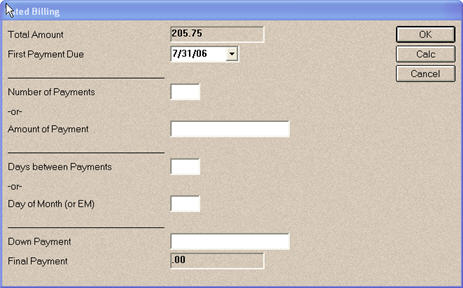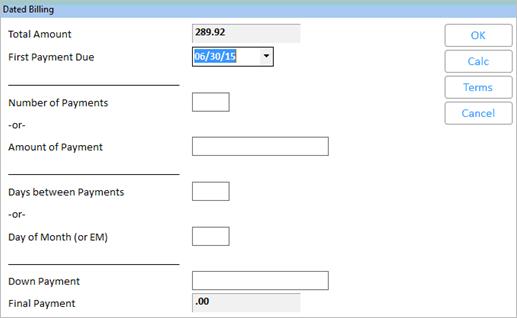Using POS Dated Billing
(A/R Pro users only)
This procedure assumes you have already completed
the setup for POS Dated Billing.
You can use Dated Billing for a POS transaction if all of the following
are true:
The
transaction type is a Sale, Order, or Special Order
The
transaction amount is greater than zero
You
have not entered a deposit (if the transactions is an Order or Special
Order)
The
"Charge Allowed" and "Allow Dated Billing" fields
are set to Y in Customer Maintenance
You
have security to use Dated Billing
Using Dated Billing
Create the transaction (Sale,
Order, or Special Order) as you normally would.
Press Total (+ on the keypad).
Important:
Since the Dated Billing function calculates with a total outstanding amount,
the counterperson procedurally would perform the Dated Billing after taking
payment for any alternate tender types (e.g. cash, credit card, etc).
Press Menu (- on the keypad),
and select Enter Dated Billing. The Dated Billing dialog box displays.
Notice the amount due is automatically entered in the Total Amount
field.


Fill in the fields as desired.
For more information about a particular
field, click any of the following.
Total
AmountThe system automatically
fills in this field with the total transaction amount.
First
Payment DueThe
due date of the first installment. If you leave this field blank, it will
default to the due date of a transaction which would appear on the customer's
upcoming statement. In other words, the transaction's terms are used in
conjunction with the projected statement date (i.e. the normal due date
calculation for a newly added transaction).
Number
of PaymentsEnter
the number of payments (between 1 and 99) you want to create for this
transaction, or leave this field blank and the system will calculate the
number of payments based on the Payment Amount field. (Note: the final
payment is counted as one of the payments)
Amount
of PaymentEnter
the amount you want the payments to be (between .01 and 9999999.99), or
leave this field blank and the system will calculate the payment amount
based on the Number of Payments field (with the possibility of a different
amount for the final payment). If you leave both this field and the Number
of Payments field blank, the <Calc> function sets this field to
the amount in the Total Amount field.
Days
between PaymentsEnter a number between 1
and 99 to determine the number of days between payments.
Day
of MonthEnter
a the day of the month (from 1 to 31), or enter EM to signify end-of-month.
If both this field and the Days between Payments field are left blank,
the <Calc> function automatically sets this field to EM. As is tru
throughout the system, 31 means the last day of the month and is equivalent
to EM.
Down
PaymentIf
the customer is giving you a down payment, enter the amount in this field.
The amount of the down payment reduces the total amount being paid by
installments.
Final
PaymentThe
Final Payment is the amount outstanding when the system divides the total
amount due by the number of payments. If the calculated final payment
is less than $1, it is added to the previous installment, making the last
installment larger than the other installments.
The final payment may be smaller, larger, or the same as the normal installment
amount. For example, if the transaction
total is $500, and you enter $60 in the Down Payment field, the system
will calculate that there will be 4 payments of 100.00, and the final
payment will be $40 (due to the $60 down payment). In contrast, if no
down payment had been entered, the Final Payment would have been 100.00
(the same as the other installments).
Important:
If the customer is
using another payment type besides Dated Billing (i.e. cash, credit
card, etc), accept the other payment type BEFORE using the Dated
Billing feature.
When using the Dated Billing
feature, you should NEVER use the Menu option "Change date
or invoice number," because this option can cause unexpected
results when used in conjunction with Dated Billing. If you need
to change the due date of a Dated Billing installment, click here.
When finished filling in
the fields, Press Calc. The fields you left blank are calculated based
on the fields you entered.
If you are satisfied with
the payments, press OK. Otherwise, make any changes, press Calc again,
and then press OK.
A summary of the dated billing
terms print in the body of the invoice (and is viewable in QuickRecall).
The following is an example for a $500 transaction with a $60 down payment;
with the balance to be paid in 5 installments (including the Final Payment).
Down
Payment (due now) 60.00
A/R
Future 440.00
First
Payment Due 06/25/06
4 Payments
100.00
Final
Payment 40.00
The Dated Billing transactions
are now stored in the A/R application, just like any other A/R transactions.
If desired, you can view
the Dated Billing transactions. If you want to change a due date,
see the topic "Dated Billing:
Changing Due Dates."



